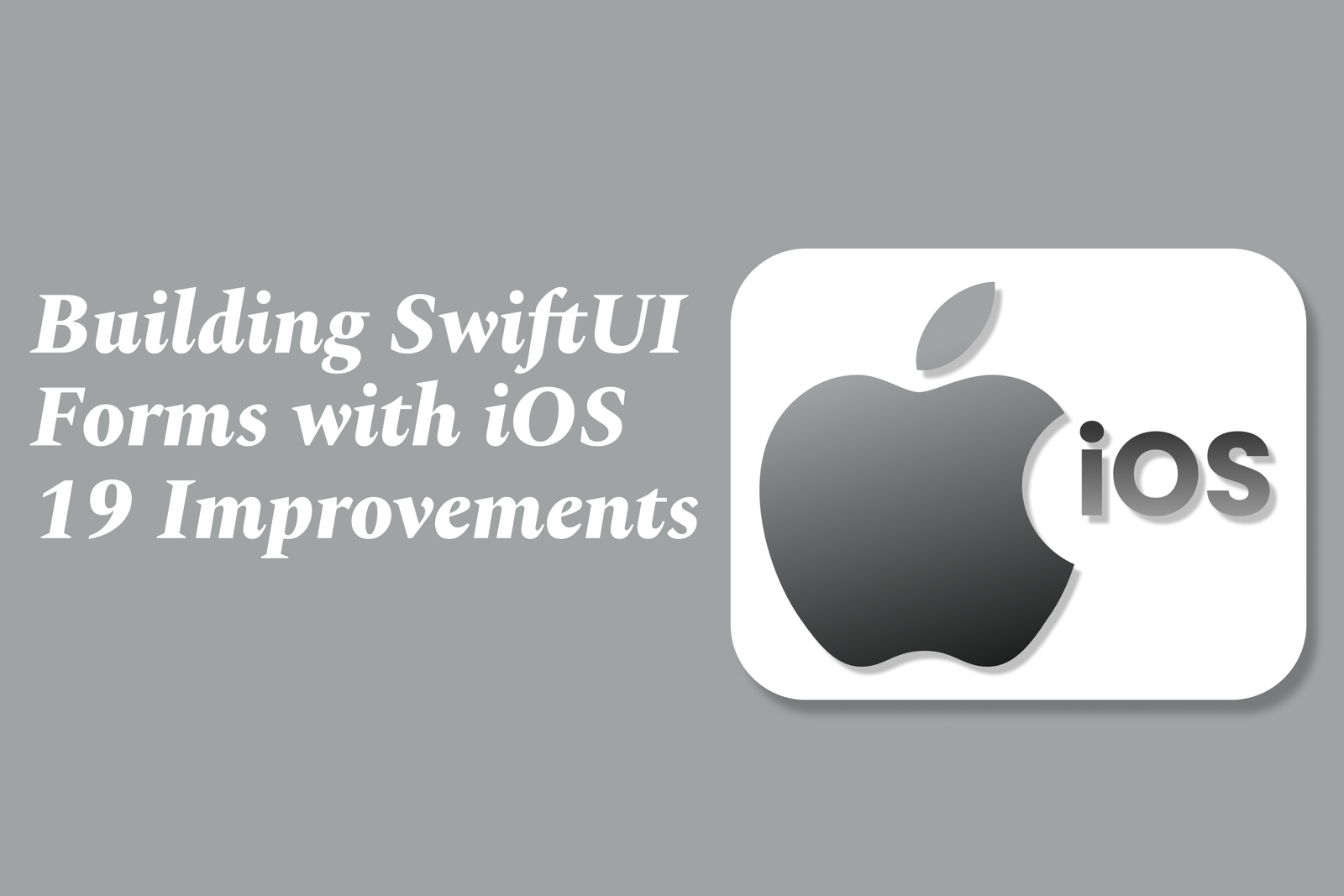Building SwiftUI Forms With iOS 19 Improvements
Building SwiftUI forms in iOS 19 is easier and more powerful with enhanced form styles, adaptive layouts, and improved multitasking support. These updates help developers create sleek, flexible data entry interfaces optimized for new devices and user experiences.
Building SwiftUI Forms with iOS 19 Improvements
1 ) Introduction to SwiftUI Forms
SwiftUI provides a Form container view designed to build user friendly data entry interfaces such as settings or profile forms. Forms automatically style controls like text fields, toggles, pickers, and more, organizing them in a platform consistent, scrolling, and responsive layout. On iOS, Forms resemble grouped rows similar to UITableView, while on macOS they appear as vertical stacks with appropriate spacing.
2 ) Creating Forms and Adding Controls
The Form component wraps various controls to create a structured layout with automatic styling.
Controls including Text, Toggle, Stepper, Picker, and Button can be embedded inside a Form to collect user input.
Using Sections inside Forms groups related controls with optional headers and footers, improving visual organization and usability.
Example SwiftUI SettingsView demonstrates how to build a multi section form with toggles for notifications and sleep tracking, a picker for mode selection, a stepper for setting sleep goal, and buttons for in app purchases.
3 ) SwiftUI’s Declarative Power and Adaptive Designs
SwiftUI forms adapt their appearance based on the container used. Wrapping elements inside Form automatically changes their style and behavior, such as presenting a separate list screen for Pickers, all without extra code. This declarative approach simplifies interactive and complex layouts.
4 ) Styling Forms with formStyle Modifier
SwiftUI supports multiple form styles via the formStyle(_:) view modifier:
Automatic: Default style using system appropriate layout.
Grouped: Uses grouped list style, typical on iOS.
Columns: Employs a grid based layout similar to macOS forms.
Developers can also create custom form styles by conforming to the FormStyle protocol, implementing the required makeBody() method to customize form appearance and behavior.
5 ) iOS 19 and Multitasking Enhancements Impact on Forms
While not directly altering forms themselves, iOS 19 introduces broader UI improvements such as Stage Manager 2.0, enabling enhanced multitasking particularly suited for upcoming foldable iPhone and iPad devices with larger, more flexible displays. These advancements will complement form based user interfaces by improving app window management and productivity workflows.
6 ) Conclusion
SwiftUI makes building forms straightforward and efficient, with powerful built in components and styling options. The improvements in iOS 19 promise to enhance multitasking and user experience on new device formats, ultimately benefiting the development and usability of SwiftUI forms. Developers are encouraged to explore SwiftUI forms for creating elegant, adaptive data entry screens with minimal code.
https://justacademy.in/news-detail/android-app-size-reduction-techniques
https://justacademy.in/news-detail/flutter-for-enterprise-level-desktop-apps
https://justacademy.in/news-detail/how-to-use-swift-playgrounds-to-learn-ios-dev-fast
https://justacademy.in/news-detail/react-native?s-latest-security-updates-keep-apps-safer-than-ever
https://justacademy.in/news-detail/why-learn-ios-development-in-2025?
Related Posts
In 2025, top Angular libraries offer modern, feature-rich components and tools for building dynamic web apps. From powerful data grids to low-code platforms like UI Bakery, these libraries enhance development speed, UI design, and scalability, making them essential for Angular developers.
Migrating from AngularJS to Angular 17 involves gradually upgrading your app by running both frameworks together using tools like ngUpgrade, rewriting components in TypeScript, and adopting Angular’s modern architecture to enhance performance, maintainability, and long-term support.
Angular state management tools help organize and handle app data efficiently, improving scalability and maintainability. Popular options include NgRx for robust, RxJS-based patterns, and newer Signal Store solutions that offer simpler, reactive approaches integrated tightly with Angular’s latest features.
RxJS in Angular empowers developers to manage asynchronous data streams with powerful operators like `forkJoin`, `combineLatest`, and `zip`. Mastering these key operators in 2025 is essential for building efficient, reactive applications that handle complex event sequences seamlessly.
Angular performance optimization in 2025 focuses on improving app speed and responsiveness by using techniques like OnPush change detection, lazy loading, efficient data caching, and AOT compilation. These practices reduce load times, enhance user experience, and ensure scalable, fast Angular applications.
In 2025, Angular remains preferred for large-scale, enterprise apps with its robust, all-in-one framework, while Vue attracts developers seeking simplicity and fast development for smaller projects. Both frameworks excel, with choice driven by project needs and team expertise.
Angular Signals are a new reactive primitive in Angular 16 that enable fine-grained, efficient change detection by automatically tracking dependencies and updating only affected parts of the UI. They simplify state management and boost app performance, revolutionizing Angular's reactivity model.
Angular interview questions to prepare in 2025 focus on core concepts like components, directives, data binding, routing, and dependency injection, along with TypeScript mastery and latest Angular features to ensure strong practical knowledge for building scalable, efficient web applications.
AngularJS reached its official end of support in January 2022, meaning no further updates or security patches. To ensure app security and performance, developers should consider migrating to modern Angular versions or seek third-party long-term support options if immediate migration isn’t possible.
The Angular Roadmap 2025 highlights upcoming features focused on improving developer experience and performance, including zoneless Angular, Signals integration, enhanced Forms, async data handling, improved HMR, and expanded Angular Material/CDK enhancements, driving modern, efficient web app development.










